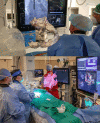Merging virtual and physical experiences: extended realities in cardiovascular medicine
- PMID: 37350487
- PMCID: PMC10499546
- DOI: 10.1093/eurheartj/ehad352
Merging virtual and physical experiences: extended realities in cardiovascular medicine
Abstract
Technological advancement and the COVID-19 pandemic have brought virtual learning and working into our daily lives. Extended realities (XR), an umbrella term for all the immersive technologies that merge virtual and physical experiences, will undoubtedly be an indispensable part of future clinical practice. The intuitive and three-dimensional nature of XR has great potential to benefit healthcare providers and empower patients and physicians. In the past decade, the implementation of XR into cardiovascular medicine has flourished such that it is now integrated into medical training, patient education, pre-procedural planning, intra-procedural visualization, and post-procedural care. This review article discussed how XR could provide innovative care and complement traditional practice, as well as addressing its limitations and considering its future perspectives.
Keywords: Augmented reality; Extended reality; Imaging; Intervention; Mixed reality; Virtual reality.
© The Author(s) 2023. Published by Oxford University Press on behalf of the European Society of Cardiology.
Figures










Similar articles
-
From static web to metaverse: reinventing medical education in the post-pandemic era.Ann Med. 2024 Dec;56(1):2305694. doi: 10.1080/07853890.2024.2305694. Epub 2024 Jan 23. Ann Med. 2024. PMID: 38261592 Free PMC article. Review.
-
Medical Extended Reality for Radiology Education and Training.J Am Coll Radiol. 2024 Oct;21(10):1583-1594. doi: 10.1016/j.jacr.2024.05.006. Epub 2024 Jun 10. J Am Coll Radiol. 2024. PMID: 38866067 Review.
-
Acceptance and use of extended reality in surgical training: an umbrella review.Syst Rev. 2024 Dec 4;13(1):299. doi: 10.1186/s13643-024-02723-w. Syst Rev. 2024. PMID: 39633499 Free PMC article.
-
Insights and trends review: Use of extended reality (xR) in hand surgery.J Hand Surg Eur Vol. 2025 Jun;50(6):762-770. doi: 10.1177/17531934241313208. Epub 2025 Jan 24. J Hand Surg Eur Vol. 2025. PMID: 39852555 Review.
-
Virtual and augmented reality for biomedical applications.Cell Rep Med. 2021 Jul 21;2(7):100348. doi: 10.1016/j.xcrm.2021.100348. eCollection 2021 Jul 20. Cell Rep Med. 2021. PMID: 34337564 Free PMC article. Review.
Cited by
-
Novel Techniques in Imaging Congenital Heart Disease: JACC Scientific Statement.J Am Coll Cardiol. 2024 Jan 2;83(1):63-81. doi: 10.1016/j.jacc.2023.10.025. J Am Coll Cardiol. 2024. PMID: 38171712 Free PMC article. Review.
-
Effects of virtual reality technology on early mobility in critically ill adult patients: a systematic review and meta-analysis.Front Neurol. 2025 Feb 5;15:1469079. doi: 10.3389/fneur.2024.1469079. eCollection 2024. Front Neurol. 2025. PMID: 39975851 Free PMC article.
-
Evolution of Telehealth-Its Impact on Palliative Care and Medication Management.Pharmacy (Basel). 2024 Apr 2;12(2):61. doi: 10.3390/pharmacy12020061. Pharmacy (Basel). 2024. PMID: 38668087 Free PMC article. Review.
-
Feasibility, Accuracy, and Reproducibility of Aortic Valve Sizing for Transcatheter Aortic Valve Implantation Using Virtual Reality.J Am Heart Assoc. 2024 Aug 6;13(15):e034086. doi: 10.1161/JAHA.123.034086. Epub 2024 Jul 23. J Am Heart Assoc. 2024. PMID: 39041603 Free PMC article.
-
Exploring Augmented Reality Integration in Diagnostic Imaging: Myth or Reality?Diagnostics (Basel). 2024 Jun 23;14(13):1333. doi: 10.3390/diagnostics14131333. Diagnostics (Basel). 2024. PMID: 39001224 Free PMC article. Review.
References
-
- Intel Unveils Project Alloy | Intel Newsroom : https://newsroom.intel.com/chip-shots/intel-unveils-project-alloy/#gs.ei...(8 October 2022).
-
- What is mixed reality?—Mixed Reality | Microsoft Learn : https://learn.microsoft.com/en-us/windows/mixed-reality/discover/mixed-r...(8 October 2022).
Publication types
MeSH terms
LinkOut - more resources
Full Text Sources
Medical
Miscellaneous

